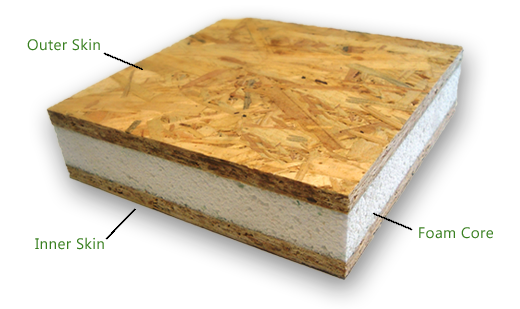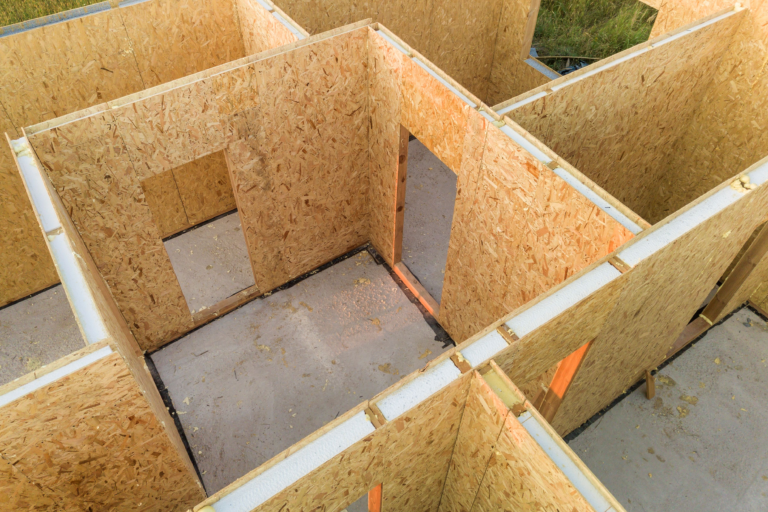What Are SIPs?

Many people ask us What Are SIPs?
SIP panels, also known as Structural Insulated Panels, are a type of building material used in construction.
These panels consist of three main components: a core material, typically made of expanded polystyrene (EPS) or polyurethane foam, sandwiched between two rigid facings, often made of oriented strand board (OSB) or plywood.
The core material provides insulation, while the facings provide strength and rigidity to the panel.
SIP panels are manufactured in a controlled factory setting, ensuring precise measurements and high-quality construction.
They are designed to be lightweight yet sturdy, making them an efficient alternative to traditional construction methods.
SIP panels offer excellent thermal performance, reducing energy consumption and promoting energy efficiency in buildings. They are versatile and can be used for walls, roofs, and floors, providing a comprehensive structural solution.
With their ease of installation, energy efficiency, and structural integrity, SIP panels have gained popularity in both residential and commercial construction projects.
What are Sips? The Advantages of SIPs Panels
- Superior insulation properties, leading to reduced energy consumption and lower heating and cooling costs.
- Enhanced thermal performance, ensuring a comfortable and consistent indoor environment.
- Airtight construction minimises air leakage and drafts, improving overall energy efficiency.
- Strong and durable, with high structural integrity and the ability to withstand extreme weather conditions.
- Quick and efficient installation due to prefabricated nature, saving construction time and labor costs.
- Precise manufacturing in a controlled factory setting ensures accurate measurements and high-quality construction.
- Versatile and can be used for walls, roofs, and floors, providing a comprehensive structural solution.
- Environmentally friendly, with minimal waste during construction and reduced carbon footprint.
- Improved indoor air quality by reducing the potential for mold and moisture issues.
- Can contribute to achieving green building certifications and energy efficiency standards.
- Offers design flexibility, allowing for customised architectural designs and versatile construction options.

Structural Insulated Panels

SIPs Panels Vs Traditional Building Methods
In the realm of construction, the advent of Structural Insulated Panels (SIPs) has revolutionised the way buildings are erected. SIPs are pre-manufactured building components that consist of a foam core sandwiched between two structural facings. As a sustainable and efficient alternative to traditional building methods, SIP panels offer numerous advantages, making them an ideal choice for modern construction projects.
Energy Efficiency and Sustainability:
One of the most prominent benefits of SIP panels is their outstanding energy efficiency. The foam core provides an exceptional thermal barrier, reducing heat transfer and preventing energy loss through walls. This results in substantial energy savings and lower utility bills over the lifespan of the building. Additionally, SIP panels are often constructed from eco-friendly materials, which significantly reduces the carbon footprint of the building process. By promoting sustainability, SIP panels align perfectly with the growing demand for environmentally responsible construction.
Rapid Construction:
Traditional building methods often involve extensive on-site labour, leading to prolonged construction periods. On the contrary, SIP panels are prefabricated off-site, allowing for quicker and more efficient assembly. The panels are custom-made to fit the specifications of the project, ensuring a seamless and time-saving installation process. As a result, SIP panel buildings can be built in a fraction of the time required for traditional structures, allowing for faster project completion and reduced overall costs.
Structural Integrity:
SIP panels offer superior structural integrity compared to traditional building materials. The combination of the foam core and the sturdy facings creates a rigid and stable structure capable of withstanding various environmental conditions, including high winds and seismic activity. This resilience not only enhances the safety of occupants but also contributes to the longevity of the building. Additionally, the airtight nature of SIP panels reduces the risk of moisture infiltration, minimizing the chances of mold growth and structural degradation.
Improved Indoor Air Quality:
The tight seal provided by SIP panels significantly reduces air leakage, making it easier to control indoor air quality. This attribute is particularly beneficial in reducing allergens and pollutants from infiltrating the living or working spaces. As a result, SIP panel buildings offer a healthier and more comfortable indoor environment, enhancing the overall well-being of occupants.
Conclusion:
SIP panels have emerged as a superior alternative to traditional building methods, offering a plethora of advantages that make them an attractive choice for modern construction projects. From energy efficiency and sustainability to rapid construction and improved indoor air quality, SIP panels excel on multiple fronts. As the construction industry continues to embrace environmentally responsible practices, SIP panels are poised to play a pivotal role in shaping a more sustainable and efficient built environment.
For more information please contact us or visit www.sips.org.
